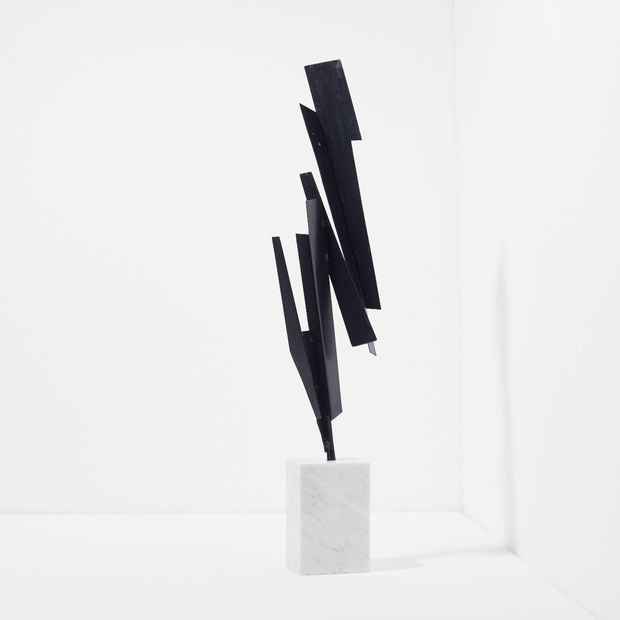Lars Erik Falk “Degrees To Slope”
Shin Gallery (66-68 Orchard St.)

[Image: Lars Erik Falk "Variety of Northern Lights" (1967) Stained Steel on Marble Base H 27.9 in.]
This event has ended.
SHIN GALLERY presents a solo exhibition of works by Swedish artist Lars Erik Falk. The mini-retrospective aims to explore Falk’s dynamic practice influenced by both the constructive and concrete art movements as a sculptor and painter. A selection of pieces spanning from the late 1940s to early 1980s, examine an important part of the artists’ oeuvre.
Born in Uppsala, Sweden, Lars Erik Falk studied in Stockholm at Otte Skold in 1944 and at the Isaac Grunewald Painting School in 1945. As a landscape painter in his early career, Falk sought inspiration by Karl Isakson, Cèzanne and the early Cubist’s. It was not until the late 1940s Falk’s fascination with constructivism and concretism became a central focus. “For me it then became natural to apply for the non-figurative art, to create images without a reference function. That art could work with only its own means - color, form, rhythm, movement etc., I experienced as a great freedom.” – Lars Erik Falk
Contemporaries and close companions, Olle Baertling and Eric H. Olson were influential models to the artist, in which their angular approach drove Falk to create works in relation to form and space. Yet, towards the end of the 1950s Falk found sculpture to be the ultimate form of artistic expression and worked exclusively with objects. The new language evolved in accordance to the change in technique, in which design became dynamic in movement as well as balanced.
Bent steel plate was the medium of choice, a resource heavily utilized for production in Sweden during the 50s and 60s. Falk’s early sculptures were almost entirely created with black paint on steel and aluminum. It was not until later, color made its entry into the artists’ practice as a result of his attraction to lacquer, which unlike other colors, retained its sound and pigment when completed. Red, orange, blue, green, gray and black were the six colors utilized by Falk later in his career.
During the 1970s, Falk’s sculptures began to articulate a strong personal identity through the use of mathematical calculation and geometric abstraction. It was at this time Falk’s fascination with the 73-degree angle overtook his practice. Always an alluding motif in his work, Falk fully committed to the 73-degree concept when working on a group exhibition. Upon installation his sculpture broke against the vertical-horizontal in the architecture of the room, which visually showed a diagonal that was neither static nor falling. This balance, about 73-degrees, gave Falk a new perspective for possibilities of variation in rhythm, balance and dynamics.
For Falk, the fixed angle was the exact position of transition between rest and dynamic movement, or as the point where equilibrium ends. Away from the static 90-degree sculpture, the 73-degree alternative points to an almost risky slope, thus inducing a desire for movement. Dialogue between balance and structure demonstrated visible simplification that acted to be a novel approach in his practice.
Towards the early 1980s, Falk’s newfound perspective garnered European attention where he held exhibitions throughout Sweden. Falk was later represented at the Modern Museum in Stockholm, Sweden National Museum in Stockholm, Musée de Grenoble and several other Swedish museums. In addition to the Nordic countries, Falk has also exhibited in France, Holland, Japan, Germany, and Switzerland.
Lars Erik Falk (1922-2018) has been exhibited in numerous solo shows including, Welamssons konstgalleri, Stockholm, 1952; Galerie Aronowitsch, Stockholm, 1967; Norrköpings Konstmuseum, 1974; Konstnärshusets Grafikgrupp, Stockholm Galerie von Bartha, Basel, 1979; Galleri Smedhamre, Uppsala, 1997; Galleri Strömbom, Uppsala, 2006; A Retrospective, Märsta Konsthall, Sigtuna, 2014-15; Galleri Mårtenson & Persson, Stockholm, 2017. Falk has had group exhibitions including, Unga tecknare, National Museum, 1951; Objekt och artefakter, Galerie Samlaren, Stockholm, 1954; Constructivism, The Modern Museum, Stockholm, 1974; Constructivist, McCrory Corp New York Kulturhuset, Stockholm, 1974; Salon Comparasions, Grand Palais, Paris, 1980; Art Concrete, Galleri Astley, Uttersberg, 1981; Striped House Museum, Tokyo, 1983; Konkret i Norden 1907-1960, Helsingfors, Odense, Oslo, Reykjavik och Norrköping Skulpturer i Park, Wanås, 1988; Tre Svenskar, Galerie Convergence, Paris, 1990; Svenskar, Galerie Hoffman, Friedberg Frankfurt, Berlin, 1996; Wanås Slottspark, Samtida nordisk skulptur 1980-2005, 2005.The artist has also done public works including, Color Tower at Lindhagensplan in Stockholm, 1981; Module Sculpture at metro station Kista in Stockholm, 1980; and Modul Sculpture, Karlshamns Energiverk, 1990;
Media
Schedule
from June 21, 2019 to July 28, 2019
Opening Reception on 2019-06-21 from 18:00 to 20:00